A Family Affair
From the Summer 2023 Issue
When county fair is more than just a visit
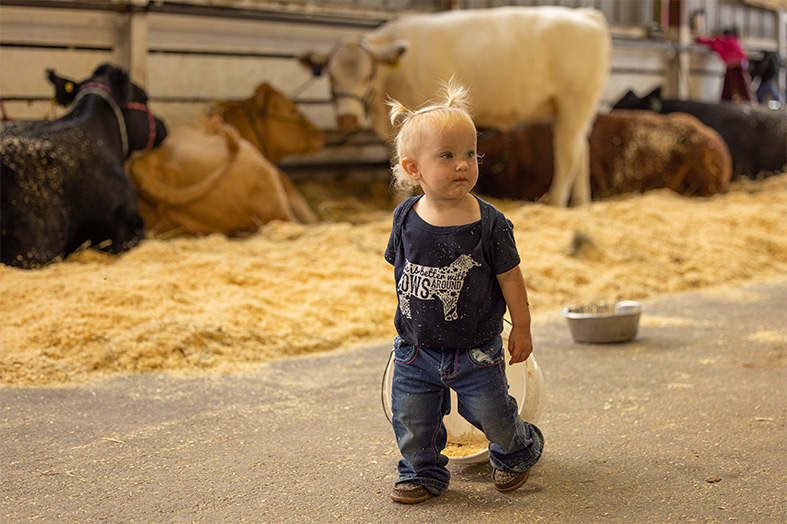
It’s 6 a.m. on an August morning. CaliJo Giard wakes up, gets dressed, and walks from her home to the nearby Holly Barn to milk Matilda.
Matilda, a 3-year-old dairy goat, provides nearly a gallon of milk daily for a foster “kid” and for CaliJo’s family.
“She gets her on the milk stand and puts her on a milking machine,” CaliJo’s mom Deanna explained. “While the machine is working, she can clean and prepare the stall and feed.”
CaliJo, 14, is taking eight projects in her seventh year as a member of the Sagle Saddle Tramps 4-H Club.
Her home, a Hideaway travel trailer housing her mom and younger sister CharliAnn, sits among RVs and tents forming a week-long community of 4-H families who live at the Bonner County Fairgrounds while tending to their animals during the annual fair.
This camping community occupies 80 spaces in designated areas around the fairgrounds. Some offer full RV hookups; others, only electricity, while others provide space for dry camping, including tents.
There’s always a waiting list for camping spots, said fair administrative assistant Maranda Montgomery. Fees range from $33 to $77. Campers at the full-hookup, horseshoe area in the trees overlooking Sand Creek must submit applications while others claim their spots on a first-come, first-serve basis.
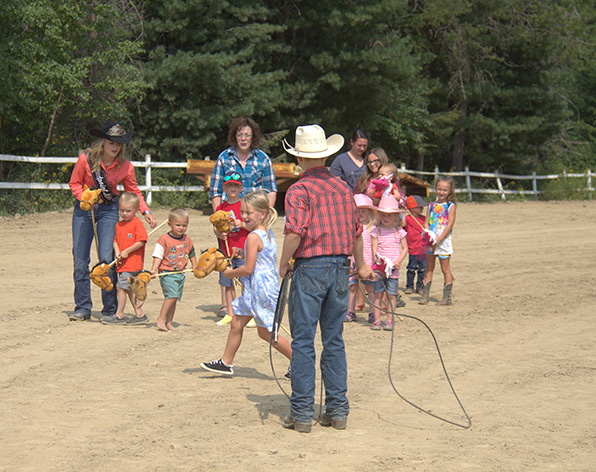
Li’l ropers and riders. PHOTO BY MARIANNE LOVE.
The camping community, representing 4-H clubs from throughout Bonner County, moves in on Sunday before the fair and leaves the following Sunday.
After campsites are set up, hundreds of animals, ranging from Levi Wood’s market steer to CharliAnn Giard’s bearded dragon, arrive later, staying in pens, cages, or tethered in respective livestock barns around the grounds. Fair superintendents oversee the daily opening and closing of barns as well as general management of the area.
Since Deanna Giard serves as goat-barn superintendent, the family’s trailer occupies a spot close by, allowing Giard and her daughters a convenient setting for fulfilling their respective fair activities.
Meanwhile, at several RVs north of the beef barn, 4-H’ers are also up at dawn, feeding their cattle and cleaning stalls.
“After the kids are done with stalls, they all work together to clean the barn to make it presentable and inviting for fair goers,” said Dana Wood, mother of three Gold n’ Grouse 4-H’ers. “They need to be around to check in on their animals every couple of hours and offer them water, especially when it’s hot.
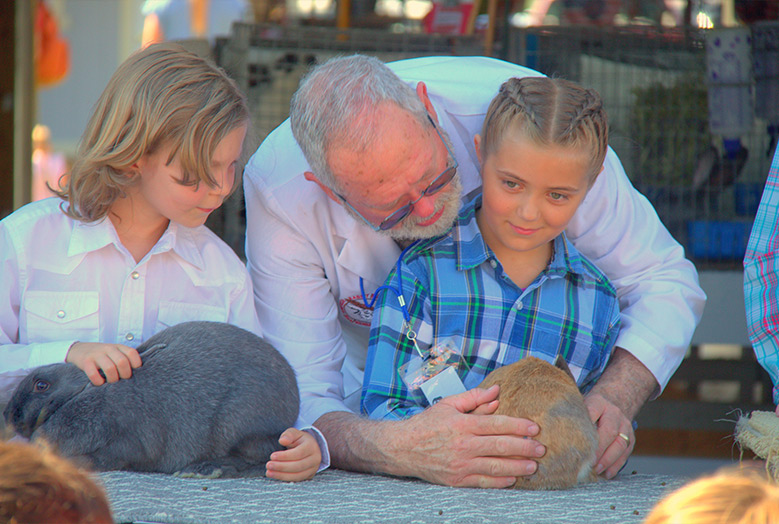
Bunnies getting judged. PHOTO BY MARIANNE LOVE.
“The camper is a great ‘landing zone’ for the kids and their friends,” she added. “They can swing by, grab a snack, sit, and relax for a few minutes or change clothes if/when needed.”
For Quentin Ducken, swine superintendent, time spent camping at the fair with his wife Anna and daughter Mayle involves vacation days which he takes off from his job with the city of Sandpoint.
“I work harder at the fair than at my normal work,” he said; “early mornings, late nights, opening, closing … helping the kids and checking on the pigs.”
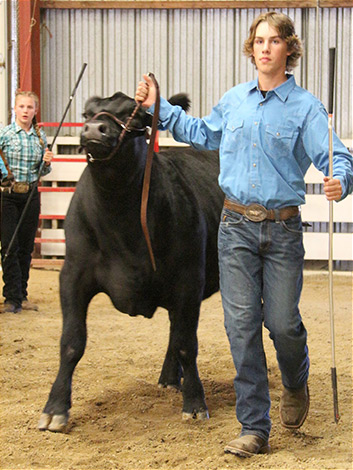
JAMES MORASCH WITH STEER.
The centrally located Ducken camping area provides an inviting atmosphere for kids with its old couch near the trailer “to make it cozy. Some may even crash on the couch,” Ducken said. “I have anywhere from two to 15 kids hanging out at my camper throughout the week.” The Ducken’s daily menu of tacos, crock-pot dishes, and even pulled pork prepared in a portable smoker, often attracts a few extra hungry mouths.
Prior organizing of clothes, cleaning supplies and food is a common ritual among campers, while some, like Fair Board member Gail Curless, a camper for several years, prefer sampling the wide variety of offerings from fair food vendors, and, of course, the popular deep-fried elephant ears.
Ben Gunter, with his wife and daughters, has camped at the fair for ten years. Both Madison and Mirabelle show and sell 4-H market animals. Madison has also reigned as Bonner County Rodeo queen for two years. With her duties of visiting area rodeos, Madison’s family travels with her.
“We keep the trailer stocked because of rodeo season,” Gunter said. “Last year we didn’t even take it home—just went right to the fair.”
The Giard family assume individual responsibilities for their trailer. CharliAnn and CayliJo organize their showing clothes and help their dad Joe, who generally stays home and takes care of other animals, set up and level the trailer at the fairgrounds.
Like many fair campers, the Giards’ generational aspect of camping adds a nostalgic touch—four generations of memories, in fact.
Deanna’s grandmother, the late Bernice Spade, a longtime 4-H leader and fair superintendent, lived in her camp trailer next to the swine barn during fair time, often taking Deanna to stay with her.
Bernice’s daughter, aka Deanna’s mom Patti Harkey, camped with her kids when they were 4-H’ers. These days Harkey, a former fair queen, visits the fair every day, watching grandchildren compete in everything from goats to rabbits. She also relaxes with family at the Giard trailer.
“I really enjoy it. We sit and talk about the day’s events, maybe have a meal or send out for something,” she said. “Last year I brought cupcakes for CayliJo’s birthday.”
A fifth generation of the family, soon to reach 4-H age, will likely extend the universally beloved fair traditions.
During each day, campsites often remain empty for hours while 4-H’ers feed, compete, or hang out with new and old friends at fair attractions and exhibits.
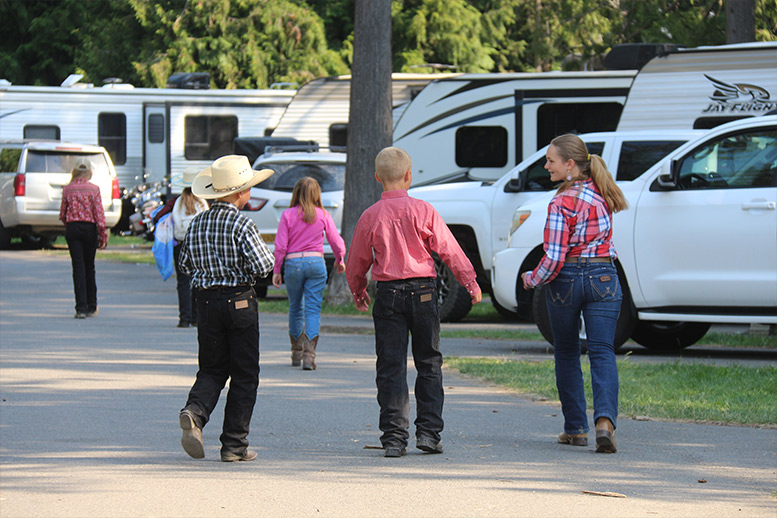
WALKING HOME TO THE TRAILERS. PHOTO BY MARIANNE LOVE
“We see them when they need money,” Giard said, “or when they come to bed by 9 or 10 at night.” During daytime hours, some parents even take advantage of the solitude by napping or reading a good book.
Each evening, campsites come alive again for family relaxation, meal times, and visiting.
“You’re part of the whole fair experience when you camp there,” said Gail Curless. “It’s a basic old time good time. It’s the friendships and, in many cases, it’s like our family reunion.”
On Sunday after the fair, the camping community shuts down with trailers headed home. Most are filled with piles of dirty clothes, fair ribbons, and trophies, all reflecting another year of good memories.
“There’s a lot of work and dedication and reward, experiencing kids having a good time showing, competing, and meeting new people,” said Quentin Ducken. “It’s a blessing to be a part of it.”
CaliJo Giard, agrees, ranking her fair experiences at “11” on a scale of 10.
“It’s our opportunity to show off the hard work we’ve done and an opportunity to inform the public,” she said. “When people see animals and projects, they learn what 4-H does for kids and how it teaches responsibility and character.”
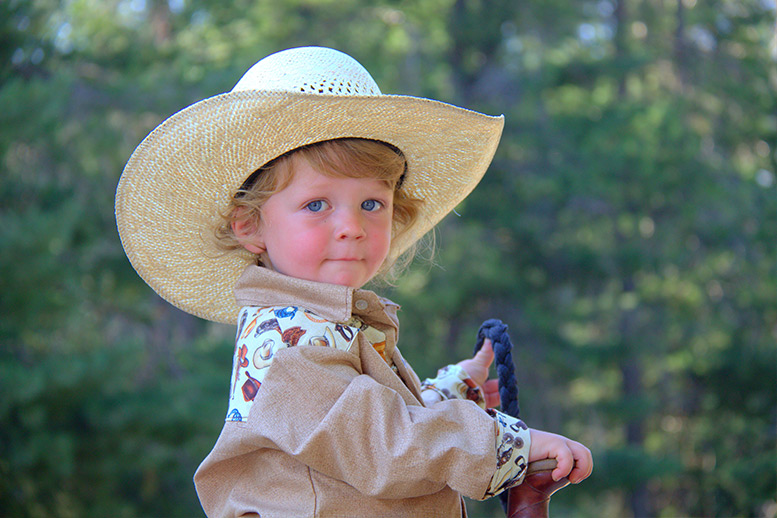
YOUNG ZEKE SCHOONOVER IS ALREADY AN OLD HAND AT BOTH HORSE RIDING AND THE COUNTY FAIR. PHOTO BY MARIANNE LOVE




Leave a comment